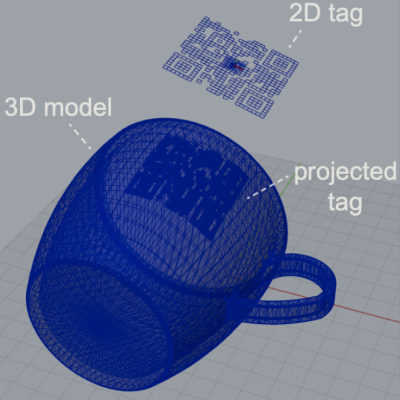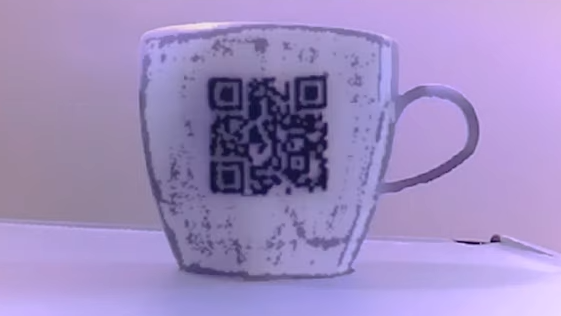An interesting research project out of MIT shows that it’s possible to embed machine-readable labels into 3D printed objects using nothing more than an FDM printer and filament that is transparent to IR. The method is being called InfraredTags; by embedding something like a QR code or ArUco markers into an object’s structure, that label can be detected by a camera and interactive possibilities open up.
 One simple proof of concept is a wireless router with its SSID embedded into the side of the device, and the password embedded into a different code on the bottom to ensure that physical access is required to obtain the password. Mundane objects can have metadata embedded into them, or provide markers for augmented reality functionality, like tracking the object in 3D.
One simple proof of concept is a wireless router with its SSID embedded into the side of the device, and the password embedded into a different code on the bottom to ensure that physical access is required to obtain the password. Mundane objects can have metadata embedded into them, or provide markers for augmented reality functionality, like tracking the object in 3D.
How are the codes actually embedded? The process is straightforward with the right tools. The team used a specialty filament from vendor 3dk.berlin that looks nearly opaque in the visible spectrum, but transmits roughly 45% in IR. The machine-readable label gets embedded within the walls of a printed object either by using a combination of IR PLA and air gaps to represent the geometry of the code, or by making a multi-material print using IR PLA and regular (non-IR transmitting) PLA. Both provide enough contrast for an IR-sensitive camera to detect the label, although the multi-material version works a little better overall. Sadly, the average mobile phone camera by itself isn’t sufficiently IR-sensitive to passively read these embedded tags, so the research used easily available cameras with no IR-blocking filters, like the Raspberry Pi NoIR.
The PDF has deeper details of the implementation for those of you who want to know more, and you can see a demonstration of a few different applications in the video, embedded below. Determining the provenance of 3D printed objects is a topic of some debate in the industry, and it’s not hard to see how technology like this could be used to covertly identify objects without compromising their appearance.
















Embedding version numbers etc. into the infill/void would be really handy, especially if a slicer plug in could take it from the file name.
this is cool but the problem now is: how do you know an object is interactable? I think text saying “scan QR here” would negate the purpose.
There are a lot of “all or nothing” type problems with
the future of tech. If everything was labeled it would make sense to have phone and ar apps that recognize everything and those apps would make labeling everything worth the effort. Self driving cars make perfect sense if every car is self driving, and roads are built with that in mind.
I see some possible usages as shortcut or enhancement on paper content where showing the QR Code would waste space and nothing*, or a small logo, would cue you.
* I mean, if you clearly state your whole book use that technology and the way it is built it is clear where you should scan it. Like how we detect ads they try to screw you up thinking it is part of the website because the website border make it clear it is an ads spot.
Stupid idea but kind of example: You remember those kids books toy like that teach you how to say what you are looking at with a pen? Embed an hidden QR Code as well. Could display the object in 3D, animate it, listen to what sound they make, show what they like/dislike, …
Encyclopedia, journal (likely just link to the article or releated pages?), schematic of some sort.
Maybe some type of puzzles. (Escape room are an original way to use RFID & reed switch)
We can’t say it is useless because we don’t see a usage for. There could be a niche we don’t know about, or a solution to a problem that will appear in 5 years.
This is one thing I like about the internet nowday, any project can be shared and it is always great to see somebody using it because it does the job for their needs.
Consider an office key card. It looks like a credit card and lacks branding, but the user knows its function. Embedded IR QR-codes could act as a secondary visual authentication like the security strip in paper currency.
A simple universal standard would include some kind of logo on the device. This is assuming that you use double shot injection molding techniques to embed a IR transparent QR code in the outer housing of a thing.
I’ve an idea: why not have the QR code visible to plain sight?
Because they are ugly and a eyesore.
You can make low contrast codes that are essentially invisible to the naked eye but are still perfectly readable for a camera
I wonder if you could use a combination such that you get one result with a normal camera and another with an IR-sensitive camera… Talk about hiding in plain sight.
I should have kept reading, as @Bob Baddeley mentions using black inks with different IR properties to do just that.
It would be useful if you’d own bitcoin. But I missed out on the pyramid scheme.
Other people could put hard disk passwords into them. The possibilities are endless.
A detailed and large IR-QR could store a GPG key.
I worked on something once where we used AR tags for tracking the location of things, but we used an IR camera and bathed the area in IR light. The cool part was that we could use two different black inks, so that while it would look like a single color on the surface, the IR camera clearly differentiated between the two inks and could track the tags with no problem. I think this is a way more practical approach than embedding the tag and using special plastics, and AR tags are a more reasonable application than QR codes.
I always thought IR qr codes could be very useful for assistive tech for people with sight issues – any written info could be tagged with a link to a plain text version online that plays nicely with text to speach.
Object recognition for dumb Ai robotic assistants. The QR code could be a pattern rather than a single placement.
This looks like close kin to my invisible ink printable QR code labels!
matrix is better than qr-code
Why should someone use this, if there is something like NFC and RfID?